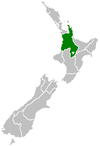Arapuni Power Station
| Arapuni Dam | |
|---|---|
 Arapuni power station, as seen from the Arapuni Suspension Bridge | |
| Country | New Zealand |
| Location | Lake Arapuni, Waikato River |
| Coordinates | 38°4′17″S 175°38′36″E / 38.07139°S 175.64333°E |
| Purpose | Power |
| Status | Operational |
| Opening date | 1929 |
| Dam and spillways | |
| Impounds | Waikato River |
| Reservoir | |
| Creates | Lake Arapuni |
| Arapuni Power Station | |
| Operator(s) | Mercury Energy |
| Turbines | 8× Francis turbines |
| Installed capacity | 196.66 MW (263,730 hp) |
| Annual generation | 805 GWh (2,900 TJ) |
Arapuni Power Station is a hydroelectric power station on the Waikato River, in the North Island of New Zealand. It is owned and operated by Mercury Energy, and is the seventh and penultimate hydroelectric power station on the Waikato River. It is also the oldest currently generating, the first government-built, and the largest capacity single hydroelectric power station on the Waikato River. The two power houses that make up the Maraetai Power Station have a larger combined capacity however.[1]
Arapuni, due to its proximity to Hamilton, plays an important part in voltage support and frequency keeping in the city and the wider Waikato region. Even though it is 80 years old, continuous improvement and refurbishment of the station's generation equipment ensures Arapuni remains efficient.[2]
The powerhouse and dam at Arapuni are under protection of the Historic Places Trust, becoming Category I Historic Places in November 1987 and August 1991 respectively.[3][4][5] It is one of the few generating power stations in New Zealand to be listed on the register.
History
Arapuni was the first government-built hydroelectric station on the Waikato River, and the second after the privately owned Horahora Power Station that was decommissioned in 1947 on the filling of Lake Karapiro.
Initial surveying of the site began in 1916, but in 1920, the surveying was halted due to lack of government funds to progress the project. Construction of Arapuni finally began in 1924, but repeated heavy rain and the resulting floods dogged the early works. The station, complete with three turbines and provisions for a fourth, was commissioned in mid-1929. Shortly after commissioning, Arapuni was closed for two years while a water seepage problem was investigated and the headrace lined. The station, with the addition of a fourth turbine, was recommissioned in May 1932.

The Arapuni Suspension Bridge, just downstream from the power station, was opened in 1926. It gave access from 'top camp' (which eventually became the Arapuni township) on the true right to the power station construction site on the true left of the Waikato River.[6]
Originally, Electricity from Arapuni was stepped up to 110,000 volts and transmitted along two lines (one single-circuit and one double-circuit) to Penrose substation in Auckland, with intermediate substations at Hamilton and Bombay. Electricity was also supplied into the Horahora system via a 110,000/50,000-volt interconnecting transformer. In 1934, a 110,000-volt line was commissioned from Arapuni to Stratford in Taranaki, connecting the station to the Mangahao-Waikeremoana system and on to the lower North Island.[7]
In 1934, increasing demand for electricity resulted in Arapuni being extended. The powerhouse was doubled in size, and provisions for four more turbines were made. Turbines 5 and 6 were commissioned four years later in 1938. The last two turbines were commissioned in 1946 to meet the increasing demand for electricity following World War II.
In 1990, a $50 million repair, refurbishment and upgrade project was completed, the first stage of which involved construction of a diversion channel.[8] In 2000 it was determined that the historic seepage problem had worsened, interim repairs were carried out while a more permanent solution was devised and this took the form of a $20 million engineering project, which was carried out in 2005–07.[9][10] In 2001, work was completed on four of Arapuni's turbines to increase capacity from 24.7 megawatts (33,100 hp) to 26.7 megawatts (35,800 hp) each and to improve their peak efficiency.[3]
References
- ^ "Hydro Generation". Mercury Energy. Retrieved 2019-10-19.
- ^ "Arapuni Technical information - Mighty River Power Generation". Mighty River Power. Archived from the original on 16 May 2008. Retrieved 2009-05-05.
- ^ a b "About Arapuni - Mighty River Power Generation". Mighty River Power. Archived from the original on 27 September 2011.
- ^ "Arapuni Powerhouse". New Zealand Heritage List/Rārangi Kōrero. Heritage New Zealand. Retrieved 2009-05-05.
- ^ "Arapuni Dam". New Zealand Heritage List/Rārangi Kōrero. Heritage New Zealand. Retrieved 2009-05-05.
- ^ "Arapuni Suspension Bridge". Historic Places Trust. Retrieved 16 January 2010.
- ^ McLintock, Alexander Hare; by Victor Albert Le Page, B. A.; Taonga, New Zealand Ministry for Culture and Heritage Te Manatu. "Transmission Systems". An encyclopaedia of New Zealand, edited by A. H. McLintock, 1966. Retrieved 2020-04-02.
- ^ "Arapuni Power Station and Dam". IPENZ. Archived from the original on 2010-05-22. Retrieved 2009-12-30.
- ^ "Extreme Group Photo Gallery Arapuni Hydro Dam". Archived from the original on 2008-10-14. Retrieved 2009-12-30.
- ^ Riley, Gavin (April 2007). "Arapuni task a world first". Contrafed Publishing. Archived from the original on 18 February 2012. Retrieved 2009-12-30.
Further reading
- Martin, John E, ed. (1991). People, Power and Power Stations. Wellington: Bridget Williams Books Ltd and Electricity Corporation of New Zealand. pp. 316 pages. ISBN 0-908912-16-1.
- Reilly, Helen (2008). Connecting the Country – New Zealand’s National Grid 1886 - 2007. Wellington: Steele Roberts. ISBN 978-1-877448-40-9.
External links
- "Hydro Generation". Mercury Energy.
- "Arapuni Power Station and Dam". Engineering New Zealand.
- Energy infrastructure completed in 1929
- Energy infrastructure completed in 1932
- Energy infrastructure completed in 1938
- Energy infrastructure completed in 1946
- Hydroelectric power stations in New Zealand
- Buildings and structures in Waikato
- NZHPT Category I listings in Waikato
- 1920s architecture in New Zealand


